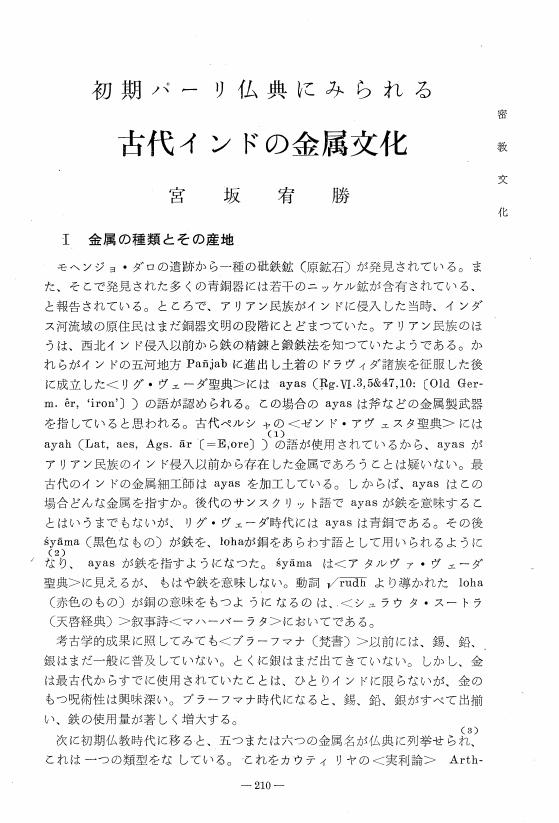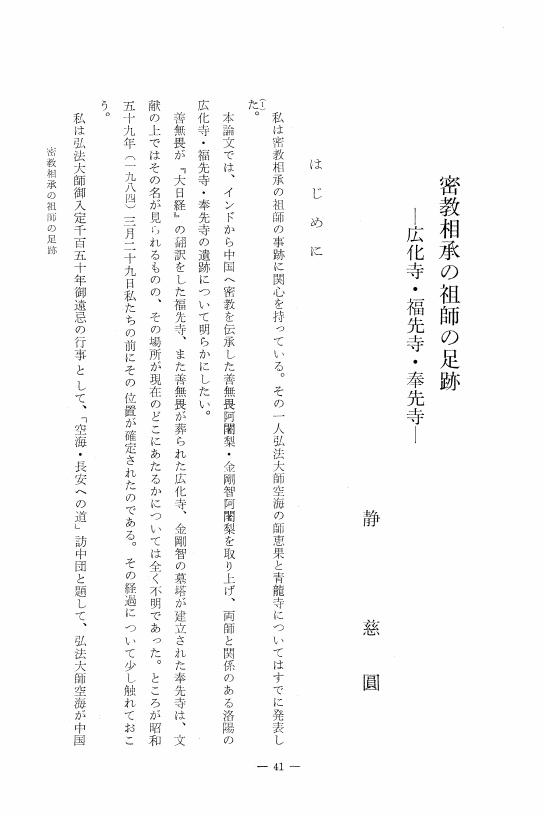1 0 0 0 OA サーンチー第二塔 記述と解釈 (一)
- 著者
- 山本 智教
- 出版者
- 密教研究会
- 雑誌
- 密教文化 (ISSN:02869837)
- 巻号頁・発行日
- vol.1963, no.63, pp.1-18, 1963-06-10 (Released:2010-03-12)
1 0 0 0 OA 初期パーリ仏典にみられる古代インドの金属文化
- 著者
- 宮坂 宥勝
- 出版者
- 密教研究会
- 雑誌
- 密教文化 (ISSN:02869837)
- 巻号頁・発行日
- vol.1960, no.48-50, pp.L210-L196, 1960-11-25 (Released:2010-03-12)
1 0 0 0 OA 秘藏寶鑰序説
- 著者
- 栂尾 祥雲
- 出版者
- 密教研究会
- 雑誌
- 密教文化 (ISSN:02869837)
- 巻号頁・発行日
- vol.1948, no.3, pp.1-11, 1948-06-20 (Released:2010-03-12)
1 0 0 0 OA 願行上人憲静の研究 (下)
- 著者
- 伊藤 宏見
- 出版者
- 密教研究会
- 雑誌
- 密教文化 (ISSN:02869837)
- 巻号頁・発行日
- vol.1977, no.119, pp.29-56, 1977-11-01 (Released:2010-03-12)
- 参考文献数
- 33
1 0 0 0 OA 魚を食う 僧霊異記下巻六縁考
- 著者
- 藤森 賢一
- 出版者
- 密教研究会
- 雑誌
- 密教文化 (ISSN:02869837)
- 巻号頁・発行日
- vol.1976, no.113, pp.1-10, 1976-02-20 (Released:2010-03-12)
1 0 0 0 OA 登山帳からみた高野参詣の諸問題 (その一)
- 著者
- 日野西 真定
- 出版者
- 密教研究会
- 雑誌
- 密教文化 (ISSN:02869837)
- 巻号頁・発行日
- vol.1975, no.110, pp.53-81, 1975-03-25 (Released:2010-03-12)
1 0 0 0 OA 金剛乗がもった女性観序説
- 著者
- 静 春樹
- 出版者
- 密教研究会
- 雑誌
- 密教文化 (ISSN:02869837)
- 巻号頁・発行日
- vol.2007, no.219, pp.L9-L40,139, 2007-12-21 (Released:2010-03-12)
- 参考文献数
- 25
In issues 216-217 of Mikkyo Bunka the author discussed the philosophical viewpoints having been held within Indian Buddhism by the three yanas of Sravakayana, Paramitayana, and Vajrayana. In the present article the author will discuss in outline the view of the position occupied by women in Vajrayana. This is a timely and cutting edge issue that involves questions revolving around feminism and postmodernism. First and foremost, we are all either male or female. Feminists have declared that textual studies forming the foundation of the humanities cannot avoid the issue of gender, but that an awareness of this has not been present initially in such studies. Some cultures have a symbol system focused on women such as is typified by the worship of the Madonna, yet contradictorily those societies in practice suppress women and take away their right to discourse. Feminism accuses the history of Indian Buddhism as being strongly androcentric, and further criticizes the cultural paradigm within Indian Buddhism in which statements of gender inequality have resorted to the shields of emptiness and transcendent practices to rationalize the suppression of women by men. Based on such criticisms, the author will present a general idea of the view of women within Vajrayana, and will provide a foundational report to serve as the basis for a constructive dialogue to approach this issue.In the first section the author provides an outline of discrimination against women in the history of Indian Buddhism. The second section will examine passages on the yogini and dakini deities developed in Vajrayana. Section three will study textual passages delineating the living yoga consorts treated as the physical manifestations of such deities. Section four will present passages describing the women who participated on an equal footing with men in the ganacakra tantric rite. In conclusion, the author will demonstrate the ideal of the female principle having been incorporated in Vajrayana doctrine and the indispensability of women in actual religious practices, in particular, the high degree of gender equality described in ganacakra meetings.
1 0 0 0 OA 磧砂版大蔵経考 (一)
- 著者
- 中村 菊之進
- 出版者
- 密教研究会
- 雑誌
- 密教文化 (ISSN:02869837)
- 巻号頁・発行日
- vol.1994, no.184, pp.1-25, 1994-02-05 (Released:2010-03-12)
- 被引用文献数
- 1
1 0 0 0 OA 五大院安然和尚の思想とその門下
- 著者
- 大山 公淳
- 出版者
- 密教研究会
- 雑誌
- 密教文化 (ISSN:02869837)
- 巻号頁・発行日
- vol.1960, no.51, pp.1-16, 1960-12-25 (Released:2010-03-12)
1 0 0 0 天社土御門神道の一考察 : 天社神道行事壇の復元
- 著者
- 仲田 篤史
- 出版者
- 密教研究会
- 雑誌
- 密教文化 (ISSN:02869837)
- 巻号頁・発行日
- no.230, pp.90-75, 2013-03
1 0 0 0 川を下る神と溯る神
- 著者
- 藤森 賢一
- 出版者
- 密教研究会
- 雑誌
- 密教文化 (ISSN:02869837)
- 巻号頁・発行日
- vol.1978, no.121, pp.14-22, 1978
1 0 0 0 OA 川を下る神と溯る神
- 著者
- 藤森 賢一
- 出版者
- 密教研究会
- 雑誌
- 密教文化 (ISSN:02869837)
- 巻号頁・発行日
- vol.1978, no.121, pp.14-22, 1978-02-28 (Released:2010-03-12)
1 0 0 0 OA 密教相承の祖師の足跡 広化寺・福先寺・奉先寺
- 著者
- 静 慈圓
- 出版者
- 密教研究会
- 雑誌
- 密教文化 (ISSN:02869837)
- 巻号頁・発行日
- vol.1987, no.159, pp.41-68, 1987-09-21 (Released:2010-03-12)
1 0 0 0 OA 曼荼羅絣線法と布字観について 太陽中心の世界観の流現
- 著者
- 大野 俊覧
- 出版者
- 密教研究会
- 雑誌
- 密教文化 (ISSN:02869837)
- 巻号頁・発行日
- vol.1969, no.87, pp.37-65, 1969-05-28 (Released:2010-03-12)
1 0 0 0 江戸仏教の戒律思想 (一)
- 著者
- 上田 霊城
- 出版者
- 密教研究会
- 雑誌
- 密教文化 (ISSN:02869837)
- 巻号頁・発行日
- vol.1976, no.116, pp.24-40, 1976
1 0 0 0 〈菩薩地戒品〉に説かれる「殺生」について
- 著者
- 藤田 光寛
- 出版者
- 密教研究会
- 雑誌
- 密教文化 (ISSN:02869837)
- 巻号頁・発行日
- vol.1995, no.191, pp.L152-L136, 1995
1 0 0 0 金剛乗とインド仏教史
- 著者
- 静 春樹
- 出版者
- 密教研究会
- 雑誌
- 密教文化 (ISSN:02869837)
- 巻号頁・発行日
- vol.2006, no.216, pp.L5-L35,166, 2006
本稿は、金剛乗がインド密教史にパラダイムシフトをもたらした問題を論じる。インド密教全体と金剛乗の関係は重層的に交錯している。筆者はこれまでに築かれた先学の研究に準拠してインド密教史を寸写し、インド仏教において金剛乗の範疇を別立する理由を論じる。次に、金剛乗を信解する阿闍梨たちが行った教判に触れ、インド密教史における時代区分に関する分析概念を提起する。この論述の過程で、我々にとって、厳密な定義は困難であるとしてもそのイメージは共有されていると考えてよい「密教」に相当する用語をインドの文献に探る。最後に、金剛乗と仏教タントリズムの概念上での同異を明らかにする。
1 0 0 0 OA 上清経について
- 著者
- 福井 康順
- 出版者
- 密教研究会
- 雑誌
- 密教文化 (ISSN:02869837)
- 巻号頁・発行日
- vol.1960, no.48-50, pp.5-18, 1960-11-25 (Released:2010-03-12)
- 著者
- 佐藤 盛仁
- 出版者
- 密教研究会
- 雑誌
- 密教文化 (ISSN:02869837)
- 巻号頁・発行日
- vol.1993, no.182, pp.1-36, 1993
1 0 0 0 OA B・R・アンベードカルの憲法思想
- 著者
- 孝忠 延夫
- 出版者
- 密教研究会
- 雑誌
- 密教文化 (ISSN:02869837)
- 巻号頁・発行日
- vol.1994, no.186, pp.94-111, 1994-03-30 (Released:2010-03-12)












